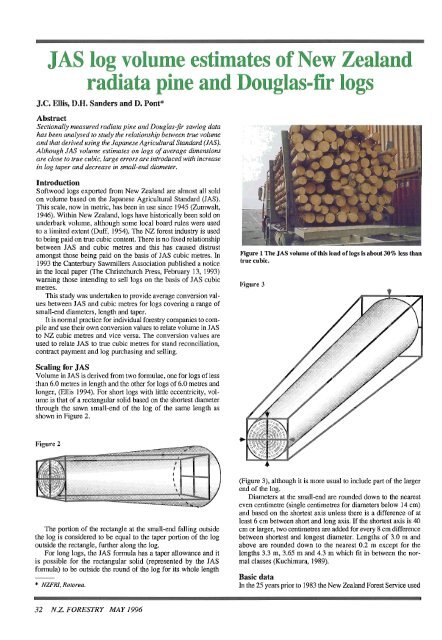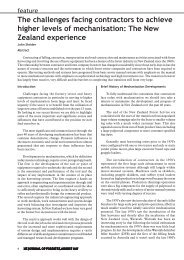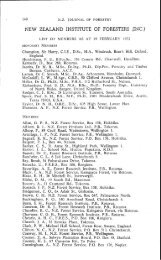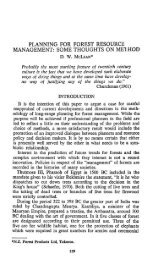JAS log volume estimates of New Zealand radiata pine and Douglas ...
JAS log volume estimates of New Zealand radiata pine and Douglas ...
JAS log volume estimates of New Zealand radiata pine and Douglas ...
You also want an ePaper? Increase the reach of your titles
YUMPU automatically turns print PDFs into web optimized ePapers that Google loves.
<strong>JAS</strong> <strong>log</strong> <strong>volume</strong> <strong>estimates</strong> <strong>of</strong> <strong>New</strong> <strong>Zeal<strong>and</strong></strong><br />
<strong>radiata</strong> <strong>pine</strong> <strong>and</strong> <strong>Douglas</strong>-fir <strong>log</strong>s<br />
J.C. Ellis, D.H. S<strong>and</strong>ers <strong>and</strong> D. Pont*<br />
Abstract<br />
Sectionally measured <strong>radiata</strong> <strong>pine</strong> <strong>and</strong> <strong>Douglas</strong>$r saw<strong>log</strong> data<br />
has been analysed to study the relationship between true <strong>volume</strong><br />
<strong>and</strong> that derived using the Japanese Agricultural St<strong>and</strong>ard (<strong>JAS</strong>).<br />
Although <strong>JAS</strong> <strong>volume</strong> <strong>estimates</strong> on <strong>log</strong>s <strong>of</strong> average dimensions<br />
are close to true cubic, large errors are introduced with increase<br />
in <strong>log</strong> taper <strong>and</strong> decrease in small-end diameter.<br />
Introduction<br />
S<strong>of</strong>twood <strong>log</strong>s exported from <strong>New</strong> <strong>Zeal<strong>and</strong></strong> are almost all sold<br />
on <strong>volume</strong> based on the Japanese Agricultural St<strong>and</strong>ard (<strong>JAS</strong>).<br />
This scale, now in metric, has been in use since 1945 (Zumwalt,<br />
1946). Within <strong>New</strong> <strong>Zeal<strong>and</strong></strong>, <strong>log</strong>s have historically been sold on<br />
underbark <strong>volume</strong>, although some local board rules were used<br />
to a limited extent (Duff, 1954). The NZ forest industry is used<br />
to being paid on true cubic content. There is no F i relationship<br />
between <strong>JAS</strong> <strong>and</strong> cubic metres <strong>and</strong> this has caused distrust<br />
amongst those being paid on the basis <strong>of</strong> <strong>JAS</strong> cubic metres. In<br />
1993 the Canterbury Sawmillers Association published a notice<br />
in the local paper (The Christchurch Press, February 13,1993)<br />
warning those intending to sell <strong>log</strong>s on the basis <strong>of</strong> <strong>JAS</strong> cubic<br />
metres.<br />
This study was undertaken to provide average conversion values<br />
between <strong>JAS</strong> <strong>and</strong> cubic metres for <strong>log</strong>s covering a range <strong>of</strong><br />
small-end diameters, length <strong>and</strong> taper.<br />
It is normal practice for individual forestry companies to compile<br />
<strong>and</strong> use their own conversion values to relate <strong>volume</strong> in <strong>JAS</strong><br />
to NZ cubic metres <strong>and</strong> vice versa. The conversion values are<br />
used to relate <strong>JAS</strong> to true cubic metres for st<strong>and</strong> reconciliation,<br />
contract payment <strong>and</strong> <strong>log</strong> purchasing <strong>and</strong> selling.<br />
Scaling for <strong>JAS</strong><br />
Volume in <strong>JAS</strong> is derived from two formulae, one for <strong>log</strong>s <strong>of</strong> less<br />
aan 6.0 metres in length <strong>and</strong> the other for <strong>log</strong>s <strong>of</strong> 6.0 metres <strong>and</strong><br />
longer, (Ellis 1994). For short <strong>log</strong>s with little eccentricity, <strong>volume</strong><br />
is that <strong>of</strong> a rectangular solid based on the shortest diameter<br />
through the sawn small-end <strong>of</strong> the <strong>log</strong> <strong>of</strong> the same length as<br />
shown in Figure 2.<br />
Mgure 1 The <strong>JAS</strong> <strong>volume</strong> <strong>of</strong> this load <strong>of</strong> <strong>log</strong>s is about 30% less than<br />
true cubic<br />
Figure 3<br />
The portion <strong>of</strong> the rectangle at the small<strong>and</strong> falling outside<br />
the <strong>log</strong> is considered to be equal to the taper portion <strong>of</strong> the <strong>log</strong><br />
outside h rectangle, further along @ <strong>log</strong>.<br />
For long <strong>log</strong>s, tb <strong>JAS</strong> formula has a taper allowance <strong>and</strong> it<br />
is possible for the rectangular solid (represknted by the <strong>JAS</strong><br />
formula) to be outside the round <strong>of</strong> the <strong>log</strong> for its whole length<br />
-<br />
* NZFRI, Rotorua.<br />
(Fgm 3), although it is more usual to include part <strong>of</strong> the larger<br />
end <strong>of</strong> the <strong>log</strong>.<br />
Diameters at the small-end are rounded down to the nearest<br />
even centimetre (single centimetres for diameters below 14 cm)<br />
<strong>and</strong> based on the &st axis unless there is a difference <strong>of</strong> at<br />
least 6 cm between s M <strong>and</strong> long axis. If the shortest axis is 40<br />
cm or larger, two centimetm am added for e v e r<br />
between shortest <strong>and</strong> longest diameter. Lengths <strong>of</strong> 3.0 m <strong>and</strong><br />
above m rounded down to the nearest 0.2 m except for the<br />
lengths 3.3 m, 3.65 m <strong>and</strong> 4.3 m which fit in between the normal<br />
classes (Kuchimura, 1989).<br />
Basic data<br />
In the 25 years prior to 1983 the <strong>New</strong> <strong>Zeal<strong>and</strong></strong> Forest Service used<br />
32 N.Z. FORESTRY MAY 19%
<strong>volume</strong> tables based on small-end diameter (underbark) <strong>and</strong><br />
length to estimate the <strong>volume</strong> <strong>of</strong> <strong>log</strong>s removed from state exotic<br />
forests. Each speciedlocality had a separate table once <strong>log</strong>ging<br />
commenced. The total number <strong>of</strong> tables produced was about 400<br />
with up to 100 in use at any one time. Tables were tested <strong>and</strong><br />
more <strong>of</strong>ten than not updated within five years <strong>of</strong> issue.<br />
The basic data for each "approved" <strong>log</strong> <strong>volume</strong> table comprised<br />
at least 200 <strong>log</strong>s. Each <strong>of</strong> them was sectionally measured<br />
for <strong>volume</strong>. This was based on diameters measured with girthtape<br />
at butt, 1.5 metres (5 feet), 3.0 metres (10 feet), 6.0 metres<br />
(20 feet) <strong>and</strong> so on from the butt, <strong>and</strong> at the small end so that no<br />
section exceeded 3 metres (10 feet) in length. Smalian's formula<br />
was then applied to each section.<br />
Many thous<strong>and</strong>s <strong>of</strong> sectionally measured <strong>log</strong>s were accumulated<br />
but for this study only the data <strong>of</strong> <strong>radiata</strong> <strong>pine</strong> <strong>and</strong> <strong>Douglas</strong>-<br />
Table 1<br />
Logs<br />
sed<br />
(em)<br />
length<br />
(m)<br />
taper<br />
(cmlm)<br />
Table 1 Radiata <strong>pine</strong><br />
Table 2<br />
Logs<br />
sed<br />
(em)<br />
length<br />
(m )<br />
taper<br />
(cmlm)<br />
Table 2 <strong>Douglas</strong> -fir<br />
min<br />
4.8<br />
2.4<br />
0.0<br />
mi11<br />
5.8<br />
38574<br />
mean<br />
25.5<br />
7.9<br />
1.09<br />
5733<br />
mean<br />
20.0<br />
max<br />
88.4<br />
18.0<br />
9.5<br />
---<br />
2.4<br />
0.1<br />
8.4<br />
1.10<br />
inax<br />
66.5<br />
15.4<br />
5.2<br />
length class (m)<br />
small-end diameter class (cm)<br />
I<br />
10-20 20-30 30-40 ALL<br />
Table 4 Number <strong>of</strong> <strong>Douglas</strong>-lir <strong>log</strong>s by diameter <strong>and</strong> length<br />
fir are used. The full range <strong>of</strong> data is shown by small-end diameter<br />
(sed), length <strong>and</strong> taper in Table 1 <strong>and</strong> Table 2.<br />
From the above range <strong>of</strong> data only those data which represented<br />
the normal extremes in <strong>log</strong> dimensions were used. Tables<br />
3 <strong>and</strong> 4 show the number <strong>of</strong> <strong>log</strong>s by length <strong>and</strong> small-end diameter<br />
for <strong>radiata</strong> <strong>pine</strong> <strong>and</strong> <strong>Douglas</strong>-fir that are used in this study.<br />
Basic data used to calculate the conversions were principally<br />
collected from domestic saw<strong>log</strong>s rather than export <strong>log</strong>s. The<br />
large amount <strong>of</strong> data adequately covers the lengths <strong>and</strong> small-end<br />
diameters common in current saw<strong>log</strong>s. Many <strong>of</strong> the <strong>log</strong> measurements<br />
were from "old crop", not young-crop st<strong>and</strong>s. It is thought<br />
that the use <strong>of</strong> taper classes should adequately represent <strong>log</strong>s from<br />
youngcrop st<strong>and</strong>s. The present <strong>log</strong> distribution <strong>of</strong> sed, length <strong>and</strong><br />
taper frts into the 0.8-1.19 cmlm taper class for the varying smallend<br />
diameter <strong>and</strong> length classes required for export grades.<br />
The study<br />
A computer program was written to process the basic data <strong>and</strong><br />
calculate sectional <strong>volume</strong>s <strong>and</strong> <strong>volume</strong>s by a variety <strong>of</strong> methods<br />
including <strong>JAS</strong>. The small-end diameters <strong>and</strong> lengths were also<br />
calculated by rounding or truncating according to the particular<br />
scaling conventions.<br />
It should be noted that the basic data (diameter <strong>and</strong> bark thicknesses<br />
along the length <strong>of</strong> each <strong>log</strong>) were in imperial units until<br />
1978. Such data were converted to metric using the values <strong>of</strong> 1<br />
inch = 2.54 centimetres <strong>and</strong> 1 foot - 0.3048 metres. For further<br />
calculations the exact figures for diameter, bark thickness <strong>and</strong><br />
length were used with no rounding.<br />
For each <strong>log</strong> the computer program calculated small-end<br />
diameter (u.b.), actual <strong>volume</strong>, <strong>JAS</strong> <strong>volume</strong>, length <strong>and</strong> taper.<br />
These data were then written to two summary files (<strong>radiata</strong> <strong>pine</strong><br />
<strong>and</strong> <strong>Douglas</strong>-fir) <strong>and</strong> analysed by a statistical program which calculated<br />
the bias in <strong>JAS</strong> <strong>volume</strong> for small-end diameter, length<br />
<strong>and</strong> taper classes. Bias is defined as 100* (<strong>JAS</strong> <strong>volume</strong> - cubic<br />
metres)/<strong>JAS</strong> <strong>volume</strong>.<br />
Results<br />
It was found that over half <strong>of</strong> the bias in <strong>JAS</strong> <strong>volume</strong> (56% radi-<br />
Table 3<br />
'igure 4a<br />
3.0-5.9 metre <strong>radiata</strong> <strong>pine</strong><br />
"8'1b.79 0.8.; .I 9 1 .2-; 59 1.6-; .99 2-;.A9<br />
Taper classes cmlm<br />
Tabk 3 Number <strong>of</strong> <strong>radiata</strong> <strong>pine</strong> <strong>log</strong>s by diameter <strong>and</strong> length<br />
Figure 4a Bias in <strong>JAS</strong> <strong>volume</strong> on sed <strong>and</strong> taper<br />
N.Z. FORESTRY MAY 1996 33
Figure 4b<br />
6.0-8.9 metre <strong>radiata</strong> <strong>pine</strong><br />
Figure 4f<br />
9.0-11.9 metre <strong>Douglas</strong> fir<br />
SED class<br />
10-20cm<br />
20-30cm<br />
30-40cm<br />
(~glLb.79 0.8.; .I 9 1.2-; ,59 1.6-\ 99 2-d.k<br />
Taper classes cmlm<br />
Figure 4b Bii in <strong>JAS</strong> <strong>volume</strong> on sed <strong>and</strong> taper<br />
Figure 4c<br />
9.0-11.9 metre <strong>radiata</strong> <strong>pine</strong><br />
@8!/b79 0.8-; 19 1.2- 5 1.6-) ,90 21:!J9<br />
Taper classes crnlm<br />
Figure 4c Bii in <strong>JAS</strong> <strong>volume</strong> on sed <strong>and</strong> taper<br />
Figure 4d<br />
3.0-5.9 metre <strong>Douglas</strong> fir<br />
(88!Lb.79 0.8.; .I 9 1.2.; .59 1.6-; .99 2-d.A9<br />
Taper classes cmlm<br />
ata <strong>pine</strong>, 62% <strong>Douglas</strong>-fir) could be accounted for by changes in<br />
sed, taper <strong>and</strong> length. Figures 4a to 4f show the bias in percent<br />
between <strong>JAS</strong> <strong>volume</strong> <strong>and</strong> true <strong>volume</strong> plotted on taper <strong>and</strong> sed<br />
for each length class.<br />
The greatest change in bias is due to changes in taper, followed<br />
by sed <strong>and</strong> then length. The figures show that the bias<br />
increases from +lo% (for 0.4 - 0.79 cdrn taper) to -77% (2.0 -<br />
2.39 cmlm taper) in <strong>radiata</strong> <strong>pine</strong> <strong>of</strong> 9.0 - 11.9 m length <strong>and</strong> 10 -<br />
20 cm sed. For any taper class the change in bias on sed class is<br />
at a maximum in the 2.0 - 2.39 cdm taper where the bias<br />
changes from -77% (10 - 20 cm) to - 1 1 % (30 - 40 cm) for <strong>radiata</strong><br />
<strong>pine</strong> in the 9.0 - 1 1.9 m length class. In the maximum taper<br />
class (2.0 - 2.39 cdm) <strong>and</strong> minimum sed class (10-20 cm) bias<br />
changes from -54% for 3.0 - 5.9 m length to -77% for 9.0 - 11.9<br />
m length in <strong>radiata</strong> <strong>pine</strong>. The bias in <strong>Douglas</strong>-fir <strong>log</strong>s is less than<br />
that 6 <strong>radiata</strong> <strong>pine</strong>.<br />
Conversion factors between cubic metres <strong>and</strong> <strong>JAS</strong> units<br />
Conversion values were calculated from the respective <strong>JAS</strong> vol-<br />
Table 5a<br />
Taper (cmlm)<br />
small-end diameter class (cm)<br />
10-20<br />
20-30<br />
30-40<br />
0.4 - 0.79<br />
0.887<br />
0.925<br />
0.970<br />
0.8 - 1.19<br />
0.809<br />
0.880<br />
0.937<br />
1.2 - 1.59<br />
0.753<br />
0.837<br />
0.901<br />
1.6 - 1.99<br />
0.690<br />
0.815<br />
0.879<br />
'88!Lb.79 0.8-; .I 9 1 .2-'I .59 1 .6-; .99 2-d.L<br />
Taper classes cmlm<br />
Figure 4d Bii in <strong>JAS</strong> <strong>volume</strong> on sed <strong>and</strong> taper<br />
6.0-8.9 metre <strong>Douglas</strong> fir<br />
2.0 - 2.39 0.651<br />
0.782 0.854<br />
Table 5a Conversion Prom <strong>JAS</strong> to cubic metres mdiata <strong>pine</strong> 3.0 - 5.9<br />
m<br />
Table 5b<br />
I<br />
Taper (cm/m)<br />
small-end diameter class (cm)<br />
~8!Lb.79 0.8-;1 9 1 .z-\,a 1 .s-; 2-A9<br />
Taper classes cmlm<br />
Figure 4e Bias in <strong>JAS</strong> <strong>volume</strong> on sed <strong>and</strong> taper<br />
Table 5b Conversion from <strong>JAS</strong> to cubic metres <strong>radiata</strong> <strong>pine</strong> 6.0 -<br />
8.9 m<br />
34 N.Z. FORESTRY MAY 1996
Table 5c<br />
Taper (cmlm)<br />
0.4 - 0.79<br />
0.8 - 1.19<br />
1.2 - 1.59<br />
1.6 - 1.99<br />
small-end diamel<br />
20-30<br />
1.119<br />
1.033<br />
0.942<br />
0.867<br />
r class (cm)<br />
30-40<br />
1.127<br />
1 .O68<br />
1.022<br />
0.959<br />
2.0 - 2.39 0.566 0.799 0.901<br />
Table 5c Conversion from <strong>JAS</strong> to cubic metres radfata <strong>pine</strong> 9.0 -<br />
11.9 m<br />
Table 5d Conversion from <strong>JAS</strong> to cubic metres <strong>Douglas</strong>-& 3.0 -<br />
5.9 m<br />
Table 5e<br />
10-20<br />
1.115<br />
0.942<br />
0.795<br />
0.662<br />
umes <strong>and</strong> actual <strong>volume</strong>s for each small-end diameter, length <strong>and</strong><br />
taper class. Each conversion factor is the <strong>JAS</strong> <strong>volume</strong> divided by<br />
the actual <strong>volume</strong>. Tables 5a to f give conversions from cubic<br />
metres to <strong>JAS</strong>, which is the amount <strong>of</strong> <strong>JAS</strong> per cubic metre. To<br />
convert from <strong>JAS</strong> units to m3, the <strong>JAS</strong> <strong>volume</strong> is divided by the<br />
table value.<br />
The precision <strong>of</strong> each table value (Table 5a to f) was calculated.<br />
The probable limit <strong>of</strong> error for each value was generally<br />
within 0.5% for <strong>radiata</strong> <strong>pine</strong> <strong>and</strong> within 1.3% for <strong>Douglas</strong>-fir.<br />
However, where there are relatively few observations such as the<br />
10-20 cm sed in the 2.0-2.39 cmlm taper class the PLE averaged<br />
9% <strong>and</strong> 16% for <strong>radiata</strong> <strong>pine</strong> <strong>and</strong> <strong>Douglas</strong>-fir respectively. The<br />
probable limit <strong>of</strong> error (PLE) is the confidence interval (approximately<br />
2* st<strong>and</strong>ard error) <strong>of</strong> each conversion expressed as a percentage<br />
<strong>of</strong> the respective average conversion value.<br />
Discussion<br />
Bias in <strong>JAS</strong> <strong>volume</strong> (Figs 4a to f) <strong>and</strong> implied in the conversion<br />
values (Tables 5a to f) are from sed which is based on girth measurement<br />
Any overestimate in diameter due to the use <strong>of</strong> the girth<br />
tape is common to sed <strong>and</strong> <strong>volume</strong> <strong>and</strong> therefore has no effect on<br />
the result. However, the <strong>JAS</strong> conventions <strong>of</strong> sed always being<br />
rounded down, <strong>and</strong> sed being based on the shortest axis, do have<br />
a direct bearing on <strong>volume</strong>.<br />
For most <strong>of</strong> the diameter range (14 cm upwards) the <strong>JAS</strong> sed<br />
is the diameter in even centimetres. For example, a diameter 25.9<br />
cm is recorded as 24 cm in <strong>JAS</strong>. In theory this rounded-down<br />
<strong>JAS</strong> should be 1.0 cm lower than the actual sed In practice, sample<br />
data show the rounded-down <strong>JAS</strong> about 0.9 cm lower than<br />
the actual sed. This is because where the diameter is close to the<br />
even centimetre, the scaler identifies a 2 mm division more easily<br />
than a single millimetre.<br />
In this study the effective <strong>JAS</strong> diameter is based on the girth<br />
tape <strong>and</strong> therefore approximates an average <strong>of</strong> shortest <strong>and</strong><br />
longest axis <strong>of</strong> the small-end section. The difference between<br />
using <strong>JAS</strong> based on average sed <strong>and</strong> "shortest" sed was examined<br />
on an external data set <strong>of</strong> 2253 export <strong>log</strong>s measured<br />
throughout <strong>New</strong> <strong>Zeal<strong>and</strong></strong>.<br />
Table 6 below shows the diameter <strong>and</strong> <strong>volume</strong> differences due<br />
to using a short axis instead <strong>of</strong> an average diameter.<br />
Species<br />
I<br />
small-end dia meter class in centinetres<br />
20.0 - 29.9 30.0 - 39.9<br />
I<br />
0.69<br />
(2.7%)<br />
0.49<br />
(1.9%)<br />
0.028<br />
(5.2%)<br />
0.026<br />
0.99<br />
(2.9%)<br />
0.65<br />
(1.9%)<br />
0.OM)<br />
(6.3%)<br />
0.046<br />
Table 5e Conversion from <strong>JAS</strong> to cubic metres <strong>Douglas</strong>-& 6.0 -<br />
8.9 m<br />
Vol reduction (m3)<br />
Table Sf<br />
Table Sf Conversion from <strong>JAS</strong> to cubic metres <strong>Douglas</strong>-& 9.0 -<br />
11.9 m<br />
l4.h%)<br />
(4.8%)<br />
Table 6 Diameter <strong>and</strong> <strong>volume</strong> reductions due to use <strong>of</strong> short ads on<br />
end section<br />
Values in brackets give <strong>volume</strong> reduction as a percentage <strong>of</strong><br />
average <strong>volume</strong>.<br />
The above reductions are independent <strong>of</strong> taper <strong>and</strong> for practical<br />
purposes do not affect length. Small-end diameter <strong>and</strong><br />
species do have an effect on the magnitude <strong>of</strong> the reduction. Volumes<br />
used in compiling the graphs (Fig. 4) <strong>and</strong> conversion values<br />
(Tab. 5) have been altered by the reductions in Table 6.<br />
<strong>Douglas</strong>-fir is more cylindrical <strong>and</strong> less tapered (for same sed <strong>and</strong><br />
length) than <strong>radiata</strong> <strong>pine</strong>. Thus <strong>Douglas</strong>-fir has higher <strong>JAS</strong> to<br />
cubic metre conversions than <strong>radiata</strong> <strong>pine</strong>.<br />
N.Z. FORESTRY MAY 1996 35
Acknowledgements<br />
This work would not have been possible without the foresight<br />
<strong>of</strong> the late G. Duff who, with G.A.V. Bary, pioneered <strong>log</strong> <strong>volume</strong><br />
tables in <strong>New</strong> <strong>Zeal<strong>and</strong></strong> for exotic conifers. The basic data<br />
were painstakingly collated <strong>and</strong> corrected by J. Penman but many<br />
<strong>New</strong> <strong>Zeal<strong>and</strong></strong> Forest Service <strong>and</strong> Forest Research Institute staff<br />
have unknowingly contributed to this work. The authors would<br />
like to thank Messrs M.O. Kimberley <strong>and</strong> A.D. Gordon for their<br />
help in setting up the statistical programs.<br />
References<br />
Anon., 1967: Japanese Ministry <strong>of</strong> Agriculture <strong>and</strong> Forestry Notification<br />
No. 1841 <strong>of</strong> December 8, 1967, new st<strong>and</strong>ards for s<strong>of</strong>twood <strong>and</strong><br />
hardwood <strong>log</strong>s.<br />
Duff G., 1954: Methods <strong>of</strong> measuring <strong>log</strong> <strong>volume</strong> in NZ. <strong>New</strong> <strong>Zeal<strong>and</strong></strong><br />
Timber Journal. Vol. 5 (9110) 1954.<br />
Ellis J.C., 1994: Procedures for the measurement <strong>of</strong> roundwood. Second<br />
edition. <strong>New</strong> <strong>Zeal<strong>and</strong></strong> Forest Research Institute, Rotorua.<br />
Kuchimura, K. 1989: Log business in Japan. Forest Products manual<br />
series (1). Japan Lumber reports. 1-14-18 Minato, Chuo-ku, Tokyo<br />
104 Japan.<br />
Zumwalt Eugene V., 1946: Log scaling in Japan. American Journal <strong>of</strong><br />
Forestry 44(7).<br />
C.3 JAPANESE AGRICULTURAL STANDARD (<strong>JAS</strong>)<br />
KOREAN INDUSTRIAL STANDARD (KIS)<br />
This method involves measuring small-end diameter inside bark<br />
<strong>and</strong> length <strong>of</strong> individual <strong>log</strong>s, then reading <strong>volume</strong> <strong>of</strong>f tables compiled<br />
from given formulae. The formulae were developed by the<br />
Japanese Ministry <strong>of</strong> Agriculture <strong>and</strong> Forestry. As <strong>JAS</strong> (KIS)<br />
measures cubic content (in m3) rather than board content, there is<br />
a better correlation between this measure <strong>and</strong> the actual cubic<br />
content. A correction in the interpretation <strong>of</strong> this method has<br />
meant that measurement <strong>of</strong> small-end diameter 'through the pith'<br />
is now 'through the centre'.<br />
C.3.1 Small-end diameter<br />
1. FOR SMALL-END DIAMETERS LESS THAN 14 CM<br />
Measure the shortest small-end diameter inside the bark through<br />
the centre <strong>of</strong> the <strong>log</strong>. Round down to the nearest whole centimetre.<br />
Example: 12.00 - 12.99 cm, record as 12 cm.<br />
2. FOR SMALL-END DIAMETERS EQUAL TO AND<br />
GREATER THAN 14 CM<br />
Measure the shortest small-end diameter inside the bark<br />
through the centre <strong>of</strong> the <strong>log</strong>. Round down to the nearest even<br />
2-cm interval.<br />
Example: 16.00 - 17.99 cm, record as 16 cm.<br />
Measure the longest* diameter inside bark through the centre<br />
<strong>of</strong> the <strong>log</strong>. This need not necessarily be at right angles to the<br />
shortest diameter. Round down to the nearest even 2-cm interval.<br />
Note that the commercial convention in NZ is to measure<br />
the second diameter at right angles to the shortest.<br />
If the shortest <strong>of</strong> these two diameters is between 14 <strong>and</strong> 38 cm<br />
(inclusive), then for every difference <strong>of</strong> 6 cm add 2 cm to the<br />
shortest diameter.<br />
If the shortest <strong>of</strong> the two diameters is equal to or greater than<br />
40 cm then for every difference <strong>of</strong> 8 cm add 2 cm to the shortest<br />
diameter.<br />
Examples:<br />
"Shortest" "Long" Difference Record as<br />
13 20 7 13<br />
16 20 4 16<br />
16 22 6 18<br />
16 28 12 20<br />
38 44 6 40<br />
40 44 4 40<br />
40 48 8 42<br />
C.3.2 Length<br />
Length is defmed as the shortest distance between the sawn <strong>log</strong><br />
ends. Lengths are measured in metres <strong>and</strong> tenths <strong>of</strong> metres <strong>and</strong><br />
rounded down to each fixed-length class. For most export sales<br />
there is an agreed overcut (about 0.1 metres) to ensure that <strong>log</strong>s<br />
are not less than the fmed lengths negotiated with the buyers.<br />
C33 Volume<br />
1. FOR LOGS LESS THAN 6 M LONG<br />
where<br />
D = shortest diameter<br />
L = length<br />
2. FOR LOGS EQUAL TO OR GREATER THAN<br />
6 M LONG<br />
where D = shortest diameter<br />
L = length<br />
LC = length in metres rounded down to<br />
nearest whole number<br />
(LC-4)/2 = a factor for taper.<br />
Example:<br />
Therefore<br />
Short diameter = 26cm<br />
Long diameter = 32 cm<br />
Length = 8.1 m<br />
D = 28,L=8.1,L6=8<br />
Volumes are calculated to four decimal places <strong>and</strong> rounded to<br />
three.<br />
CONSULTATION<br />
RECOGNITION<br />
The following have applied for recognition as general<br />
forestry consultants in <strong>New</strong> <strong>Zeal<strong>and</strong></strong> <strong>and</strong> overseas.<br />
Bruce McVeigh Revington<br />
Owen Cox<br />
Neil George Woods<br />
Ian Marshall Wallace<br />
Donald Robert Hammond<br />
Alex<strong>and</strong>er Roberton Rae<br />
Opotiki<br />
Wellington<br />
Auckl<strong>and</strong><br />
Gisbome<br />
Rotorua<br />
Christchurch<br />
The following has applied for recognition as a specialist<br />
forestry consultant in <strong>New</strong> <strong>Zeal<strong>and</strong></strong> <strong>and</strong> overseas.<br />
Robert Browne Tennent<br />
Rotorua<br />
Under the NZIF constitution, any members <strong>of</strong> the Institute<br />
may send objections in writing within 40 days <strong>of</strong> Journal<br />
publication to the Registrar, NZIF Consultants<br />
Committee, PO Box 1340, Rotorua.<br />
36 N.Z. FORESTRY MAY 1996





